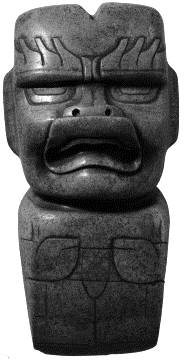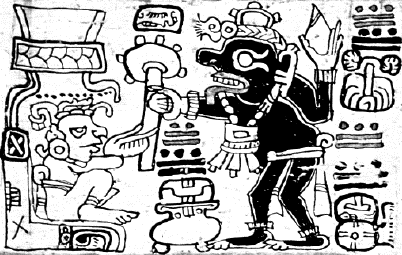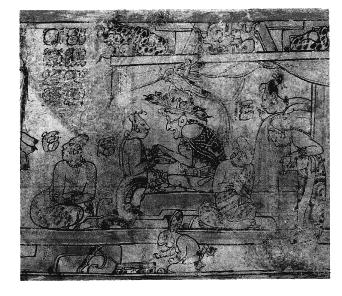Mexico
The History and Culture
of the Maya, Aztecs, and
other Pre-Columbian
Peoples
Maria Longhena
(Stewart, Tabori & Chang)

It's not an exact equation. The Aztecs, for example, never had to worry about elective government. Like the medievalists, they knew where power came from (The Above) and the priests' tasks were to be sure that the citizens paid appropriate homage to the appropriate deities.
The Roman Empire, according to Gibbon, fell apart under the onslaught of Christianity. The mesoamericans, as well, disappeared into the maw of Christianity with --- one thinks --- a little more anguish. For the Pre-Columbians lost fifteen hundred years of culture and 80% of their population in a span of a little over three decades, under the heavy cross of the church and the rape (and concommitant diseases) of the Spanish conquistadores.
In truth, the Spaniards, fresh from driving the moors from the Iberic subcontinent, unleashed on the New World their own version of "ethnic cleansing." They were horrified at the blood sacrifice they found in the Aztec religion so they loosed --- between 1520 and 1550 --- enough bloody mayhem to avenge the victims of the Aztec priests a million times over. How strange it is that the citizens of Mexico, Guatemala, Honduras, and El Salvadore, still are kind enough to honor the coming of Cristobal Colón.
The Spaniards reported that when they came upon what is now Mexico City, it was like a dream, with its spotless streets, floating gardens, and a population of 300,000 people --- free of poverty, contamination and ruination. The Iberics were quick to fix that. Within a few years, they infected the new world with not only their sex-borne diseases, but their burning gold-hunger as well. It was not just a plague from the East: it was an erasure --- the men of the sword destroying the cities and most of the countryside, the men of the cross destroying the culture: trashing the religious figures, art, buildings, and the codix (the book of cultural history that the Aztecs had so carefully devised).
 But who was conquered? And by whom? After their astonishing thirty year ravishment (see Prescott's The Conquest of Mexico and The Conquest of Peru), the Spaniards quickly devolved into a torpor that lasted well into the 19th century, until, finally, they were driven out. I say "driven out" --- but how can you drive out your own progeny, the product of three centuries of intermarriage and forcible rape (what the Mexicans call "coger" --- to get --- in the fullest sense of the word.) By the time of the Spanish-American War, it was impossible to differentiate between the conquered and the conquerers.
But who was conquered? And by whom? After their astonishing thirty year ravishment (see Prescott's The Conquest of Mexico and The Conquest of Peru), the Spaniards quickly devolved into a torpor that lasted well into the 19th century, until, finally, they were driven out. I say "driven out" --- but how can you drive out your own progeny, the product of three centuries of intermarriage and forcible rape (what the Mexicans call "coger" --- to get --- in the fullest sense of the word.) By the time of the Spanish-American War, it was impossible to differentiate between the conquered and the conquerers.
What Ms. Longhena has collected here are facts, many facts, and art, wonderful art: sculptures, edifices, and statuary to give us all a great sadness at the eight cultures overwhelmed; double sadness at the desire of their conquerers to expunge every vestige of those cultures.
The original settlers --- the Olmecs --- lived 2,500 years ago in the Gulf region of Mexico, and were followed by the Zapotecs of Oaxaca, the Teotihuacan and El Tajíns, and finally by the Mayans and the Aztecs. Most lived in the coastal and plains areas of mesoamerica, but placing them in the same book is about as selective as publishing a book about "African" art. We are dealing here not with eight cultures, but hundreds of them. Their differences may well outweigh their similarities --- outside of the fact that they all did pottery and masks, built pyramids, were ravished by the visitors from the East, lived in and around what we think of now as Southern Mexico and Central America, and ate, drank, loved, and died.
Ms. Longhena has presented us with a double-header here. The first is precolumbian culture and art. The second is a pictorial guide to twenty-three archeological sites --- from the very familiar ones (Monte Alban, Uxmal, and Palenque), to the obscure (Labna, Sayil, Edzna, and Kabah). Each of these subchapters gives us masks, buildings, pyramids, possible reconstructions of the villages and some of the more interesting statuary (including dear Chacmool --- that semi-reclined figure, knees in the air, head turned to the side, looking right at you).
 Ancient Mexico costs sixty bucks --- and would break your arm if you tried to take it along on excursions in those hot, damp, and mosquito-ridden venues. On the other hand, we have always suggested that people who own gorgeous books like this take the time to eviscerate them: don't leave them on the coffee table, for crumb's sakes; take them apart, hang the wonderful photographs on the refrigerator, in the bathroom, on the telephone pole down the block --- let the world in on these rich and tasty scenes.
Ancient Mexico costs sixty bucks --- and would break your arm if you tried to take it along on excursions in those hot, damp, and mosquito-ridden venues. On the other hand, we have always suggested that people who own gorgeous books like this take the time to eviscerate them: don't leave them on the coffee table, for crumb's sakes; take them apart, hang the wonderful photographs on the refrigerator, in the bathroom, on the telephone pole down the block --- let the world in on these rich and tasty scenes.
If you do plan to use the book for a journey to, say, Copán --- get yourself a razor and extract those nine pages, including a huge fold-out showing the way the city must have appeared in 738 when, Ms. Longhena informs us, the king of Copán, known to his subjects as "Eighteen Rabbit," was beheaded. The details are all here --- its forty acres, the Hieroglyphic Stairway that is probably the biggest history book in existence: sixty-three steps with 2,500 glyphs, telling you more than you want to know about the historical events of Daddy Rabbit and his many bunny-wabbits. At worst, you could spend some time with Ancient Mexico to decide which of the twenty-three you want to visit: The Fortress by the (Glorious) Sea (Tulum), The Home of the Olmec Colossi (Villahermosa), the Metropolis on the Lake (Tenochtitlan), the Unresolved Enigma (Cacaxtla).
 NOTE: Just to confuse us, the same publisher has published, The Maya: Life, Myth, and Art, by Timothy Laughton. It tells us that the Maya lived from 2,000BCE to the 1500s. Thus, the Maya all died 500 years ago, which would surprise some of the people Chiapas (the theory is that the present uprising in Chiapas is just another sign that the Conquest of Mexico was another sloppy piece of Iberian worksmanship --- it never got finished). Furthermore, Laughton doesn't seem to buy into the divisions devised by Ms. Longhena, viz, the Toltecs, the Teotihuacan, El Tajíns, etc. Perhaps the publisher should be kind enough to introduce them to each other. The Maya has some dandy sketches of the kings, those characters, like us, with artifically flattened foreheads (unlike Mumsie, Mayans thought us flattops to be quite beautiful).
NOTE: Just to confuse us, the same publisher has published, The Maya: Life, Myth, and Art, by Timothy Laughton. It tells us that the Maya lived from 2,000BCE to the 1500s. Thus, the Maya all died 500 years ago, which would surprise some of the people Chiapas (the theory is that the present uprising in Chiapas is just another sign that the Conquest of Mexico was another sloppy piece of Iberian worksmanship --- it never got finished). Furthermore, Laughton doesn't seem to buy into the divisions devised by Ms. Longhena, viz, the Toltecs, the Teotihuacan, El Tajíns, etc. Perhaps the publisher should be kind enough to introduce them to each other. The Maya has some dandy sketches of the kings, those characters, like us, with artifically flattened foreheads (unlike Mumsie, Mayans thought us flattops to be quite beautiful).
There are, in addition, many panoramic pictures in full color from the pottery (some are reproduced above). The Maya consists of 144 pages costing $27.50, which works out to 5.23 cents a page. Ancient Mexico, on the other hand, is twice the size with 292 pages (split the difference and call it 584), and at $60 a shot, it works out to 1.03 cents a page. Thus the latter is what our friend Ignacio would call Better Value.